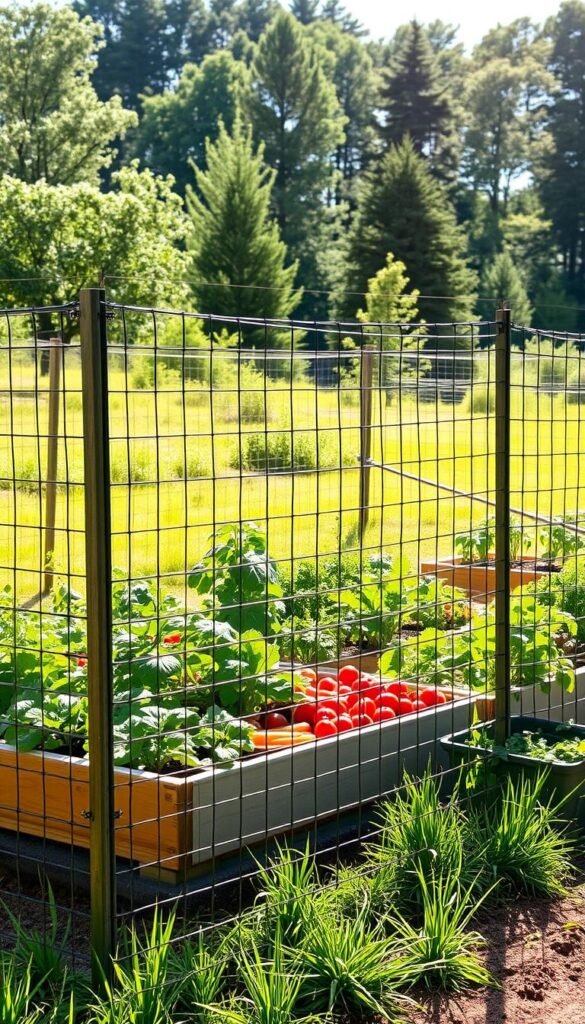Picture this: you’ve spent weeks nurturing seedlings, carefully tending rows of greens, and eagerly anticipating your first ripe harvest. Then, overnight, your hard work vanishes. Chewed stems, trampled beds, and half-eaten produce tell the story—wildlife found your edible oasis. Sound familiar?
This frustration isn’t unique. Many growers face the same challenge when hungry visitors treat their plots like all-you-can-eat buffets. While temporary fixes like sprays or noise makers might offer short-term relief, they rarely stop determined animals for long.
That’s where smarter strategies come in. Physical barriers consistently outperform other methods because they address the root issue: access. By creating a secure boundary, you eliminate opportunities for damage before it starts. Think of it as building a peaceful coexistence—your crops stay safe, and local wildlife finds meals elsewhere.
Modern designs prove that practicality doesn’t mean sacrificing beauty. Today’s enclosures blend seamlessly into landscapes while offering customizable options for different spaces. Whether you’re growing herbs in raised beds or maintaining sprawling rows, there’s a solution that fits.
Investing in proper protection now saves countless hours later. Imagine harvesting tomatoes instead of replanting them—season after season. Let’s explore how to create a thriving, resilient space that grows more than just plants…it grows confidence.
Understanding Wildlife Threats in Your Garden
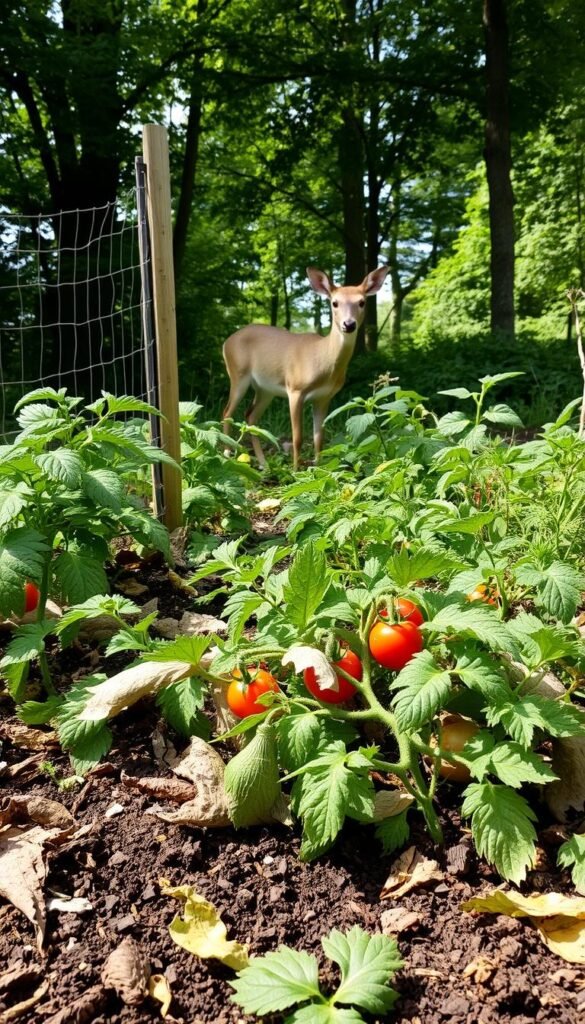
Ever found mysterious bite marks on your crops overnight? Knowing which animals visit your growing space helps tailor defenses effectively. Let’s decode the clues left behind.
Identifying Common Pests and Animals
Deer leave jagged edges on plants since they lack upper front teeth. Their tracks resemble upside-down hearts in soft soil. These grazers often strike at dawn or dusk, favoring beans and leafy greens.
Rabbits create clean, angled cuts on stems with their sharp incisors. Look for pea-sized droppings near nibbled seedlings. Their small size lets them squeeze through gaps wider than 3 inches.
How Wildlife Affects Your Vegetable Crops
Different pests attack various plant parts. Groundhogs dig under fences to devour roots, while squirrels raid tomatoes from above. Voles create hidden tunnels that collapse young plants.
Seasonal patterns matter. Spring brings hungry rabbits to tender shoots, while fall sees deer preparing for winter by stripping bark. Raccoons become bold in summer, washing food in birdbaths before feasting.
Enclosed Vegetable Garden Solutions: Protect Plants from Deer and Rabbits
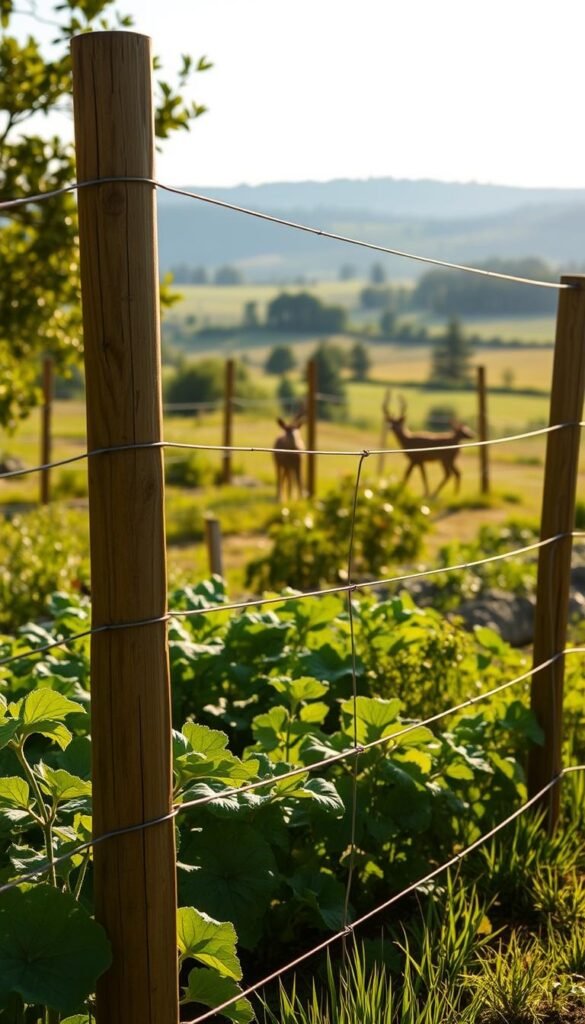
Creating effective barriers starts with understanding your space. Walk your property at different times to spot animal trails or nibbled foliage. This reconnaissance helps match defenses to actual threats.
Tailoring Protection to Your Space
Deer behavior drives design choices. Experts at Deerbusters note these animals won’t jump if they can’t see landing zones. That’s why solid 8-foot fencing outperforms shorter options—it blocks both vision and access.
For rabbits, focus below ground. A three-foot barrier works if buried six inches deep. Pair this with gravel trenches to deter diggers.
Smart Material Choices
The innovative double-fence approach uses psychology against deer. Two five-foot barriers spaced five feet apart create visual confusion. This costs less than tall single walls while blending into landscapes.
Consider your soil type when installing posts. Sandy soils need deeper footings, while clay holds better. Modular systems adapt as your garden grows, letting you add sections yearly.
Remember: effective barriers address both height and depth. Combine vertical protection with buried mesh to keep deer and burrowers out completely.
Choosing the Right Materials and Fencing Techniques
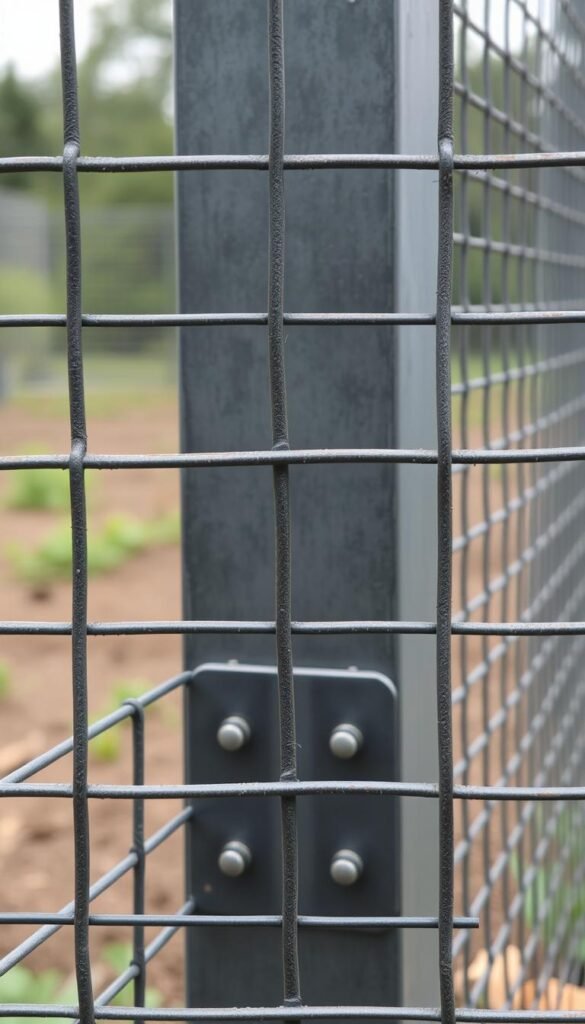
Durable defenses begin with understanding which materials turn curious visitors into passing spectators. Your barrier’s success hinges on matching metal strengths and mesh patterns to specific intruders’ behaviors.
Selecting Durable Fencing (Metal, Mesh, and Hog-Wire)
Rabbits gnaw through plastic like it’s celery. Opt for metal fencing—it withstands sharp teeth and seasons. Hog-wire panels framed in cedar offer charm and function. They double as trellises for peas or dwarf apple trees.
Graduated mesh works smarter. Tiny gaps near soil block bunnies, while larger openings up top let you monitor crops. This layered approach stops diggers without creating visual walls.
For underground threats, ¼-inch galvanized hardware cloth acts as hidden armor. Bury it 12 inches deep around beds. Pair with gravel trenches to make sure voles hit dead ends.
Consider these factors when choosing material:
- Gauge thickness (14-gauge resists bending)
- Rust resistance (hot-dip galvanizing lasts decades)
- Frame options (cedar resists rot, steel withstands storms)
Mix materials strategically. Use mesh for vertical sections and solid metal posts at corners. This balance keeps deer guessing while supporting heavy squash vines.
DIY Installation and Maintenance Tips for Your Garden Fence
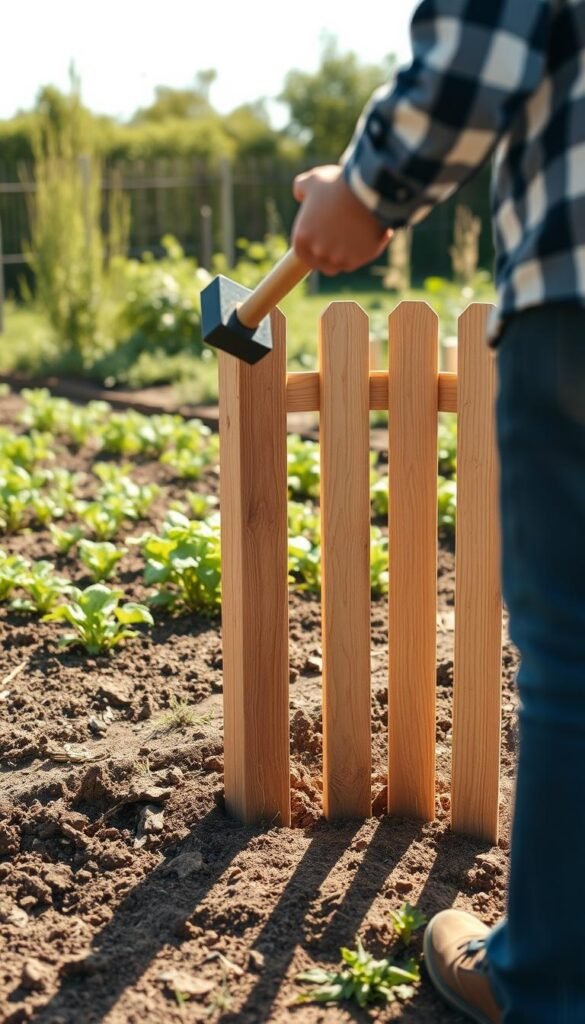
Your shovel hits dirt, and suddenly you’re not just building a barrier—you’re creating a lasting defense. Smart setup now means fewer headaches later. Let’s turn your growing space into a fortress that evolves with the seasons.
Step-by-Step Setup Guide
Start by marking your perimeter with stakes every 8 feet. This spacing keeps posts stable without wasting materials. Dig holes 18 inches deep—add gravel for drainage in wet areas.
Bury hardware cloth 10 inches down where rabbits roam. Bend the bottom 6 inches outward to form an L-shape underground. This “apron” stops diggers better than vertical barriers.
- Use galvanized staples to secure mesh to wooden posts
- Install raised beds at 4-foot height to skip digging
- Angle fence tops outward to deter climbers
Maintaining Your Fence Seasonally
Spring thaw reveals weak spots. Check ground-level connections and replace rusted fasteners. Clear leaves that hide chew marks near beds.
Before winter, wrap vulnerable posts with waterproof tape. This prevents frost damage in northern zones. Trim nearby shrubs to maintain 3 feet of clearance—eliminates hiding spots.
Every 3 years, test post stability by pushing firmly near the base. Loose posts need fresh concrete or soil tamping. Seasonal care keeps your space secure through storms and heat waves.
Integrating Additional Wildlife Deterrents Around Your Garden

Layering defenses creates a fortress that confuses hungry visitors. While fences form the backbone of protection, smart add-ons amplify their effectiveness. Let’s explore how to combine practical tools with clever psychology.
Natural and Homemade Repellent Options
Deer repellents using household items save money and time. Mix two eggs with a tablespoon of cayenne pepper and garlic—spray this cocktail on plant leaves. The stinky scent repels browsers for up to five days.
Human hair stuffed into mesh bags offers temporary relief. Hang these near vulnerable plants to exploit wildlife’s fear of human presence. For rainy areas, Irish Spring soap shavings work similarly—but refresh weekly.
Using Motion-Activated Sprinklers and Other Innovations
Modern tech brings surprise tactics. Motion-activated water systems blast intruders with sudden sprays. Animals learn to associate your space with startling showers, creating lasting avoidance.
Combine these with rotating deterrents. Tin pie pans clatter in wind for a week before losing impact. Alternate them with battery-powered radios playing talk shows. Commercial liquid fence products shine in small zones—apply after rain for maximum staying power.
Time applications with animal routines. Refresh scent barriers at dusk when deer forage. Set sprinklers to active mode during dawn raids. This strategic layering turns your growing area into a puzzle pests can’t solve.
Customizing Your Garden Design for Aesthetic and Functionality
Imagine stepping into a space where every plant thrives in its perfect spot. Strategic layouts blend beauty with practicality, turning your growing area into both a sanctuary and powerhouse. The secret lies in thoughtful design that works with your land, not against it.
Smart Layouts Meet Growing Needs
Three-foot-wide raised beds let you tend crops without straining. Their one-foot height warms soil faster in spring and drains better after storms. Pair these with narrow pathways lined with crushed granite for stable footing.
Got climbing crops? Attach cattle panel trellises directly to fence posts. This doubles your growing area while keeping squash vines off the ground. For berries, install tension wires between cedar posts—they’ll support canes better than flimsy stakes.
Retrofit existing beds with simple upgrades. Drill 7/8-inch holes along bed edges to secure hoop frames. These hold row covers that shield seedlings from frost and pests. Come summer, swap covers for shade cloth to prevent leaf scorch.
Mix depths for different crops. Shallow 6-inch raised beds suit lettuce near sunny fences. Deeper 18-inch versions give carrots room to stretch. Leave 4-foot aisles between rows for comfortable kneeling and tool storage.
Successful designs balance form and function. Curved garden space layouts soften angular fences, while staggered planting heights create visual interest. Your sanctuary becomes a living tapestry that nourishes both body and soul.
Wrapping Up Your Garden Protection Strategy
You’ve reached the final piece of your defense puzzle. While sprays and scare tactics might buy time, physical barriers stand as the only surefire way to keep persistent deer rabbits from treating your crops like a buffet. Think of your fence as the foundation—everything else supports it.
Quality enclosures pay for themselves over seasons. Those upfront costs? They’re investments in future harvests. You’ll spend less time replanting and more time enjoying plump tomatoes or crisp greens.
Pair your barrier with smart extras. Motion sprinklers add surprise, while natural repellents handle curious pests. Check connections each spring and replace worn hardware—it’s like giving your gardens a yearly checkup.
Success breeds confidence here. With fewer invaders, you’ll experiment with delicate herbs or expand your berry patch. Local growers prove layered strategies work best—adapt their tricks to your unique space.
Now’s your moment. Build that resilient boundary, tend it well, and watch your gardens thrive. Your future self will thank you with every untouched leaf and unbroken stem.
